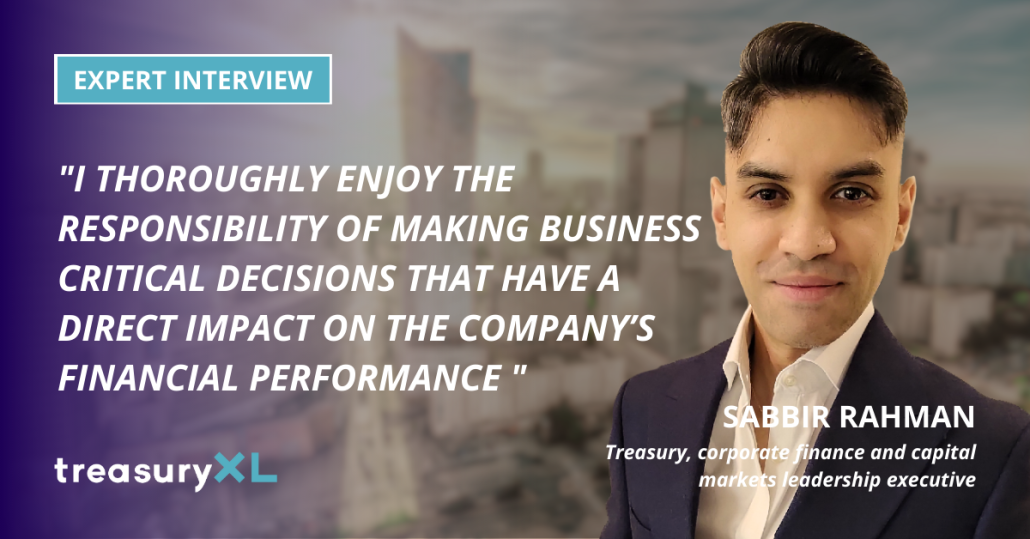Introduction Interview | 6 questions for Sabbir Rahman, treasury, corporate finance and capital markets leadership executive
By treasuryXL
We are so happy to introduce Sabbir Rahman as our newest treasuryXL expert. Sabbir is a treasury, corporate finance and capital markets leadership executive with 17 years’ experience. He has over £60 billion of transactional experience advising or directly supporting C-suites and Boards of publicly-listed and PE-backed businesses with financial modelling, legal documentation negotiation and due diligence for debt and equity financings, debt refinancings, debt restructures, mergers, acquisitions, carve-outs, divestments, PE-exits, JVs, minority interest investments and derivatives transactions.
1. How did your treasury journey start?
I began by working in sell-side investment banking where, over a period of 10 years, I provided publicly listed and PE-backed companies, and PE funds themselves, with the full suite of treasury products and services that corporates consume. These included providing debt and equity financing solutions to CFOs and Group Treasurers and providing financial risk management solutions (across FX, interest rates and commodities), investment management solutions (across money market funds, money market deposits and structured products) and cash and liquidity management solutions (such as FX swaps and money market loans and deposits) to Group Treasurers and treasury dealing teams. I subsequently received an opportunity to leverage my sell-side front office treasury markets and financing experience in a buy-side corporate treasury role as Head of Treasury for a private equity backed technology business that was eventually acquired by Mastercard. I have since held Group Treasurer roles over the past decade for several organisations, including a FTSE 250 listed global fashion retailer with £4bn annual revenue.
2. What do you like about working in Treasury?
I thoroughly enjoy the responsibility of making business critical decisions that have a direct impact on the company’s financial performance and its ability to fund its operations and financial obligations as they come due, whether these decisions be regarding long term debt and equity financing, investment management, financial risk management or cash and liquidity management. In particular, I thoroughly enjoy the exposure to a breadth of professionals, both internally and externally, when managing debt and equity financing transactions, such as company c-suite management, external bankers and other institutional creditors and internal and external legal counsel.
3. What is your Treasury Expertise and what expertise gives you a boost of energy?
My expertise can be subdivided into operational treasury, strategic treasury and organisational management and leadership skills.
In terms of operational treasury, I have specialist quantitative financial mathematical skills that I leverage with regards to financial risk management. I apply my knowledge of Markov’s Portfolio Theory, variance-covariance matrices and portfolio optimisation models to minimise risk of portfolios of risk exposures across foreign exchange, interest rate and commodities incurred by businesses. I also apply my quantitative mathematical knowledge with regards to derivatives pricing models, such as the Heath-Jarrow-Merton interest rate model, the SABR model, Monte-Carlo simulation methods, PDE (partial differential equations) grids and the Black-Scholes models to accurately price and risk manage positions in vanilla swaps and options and lightly structured and exotic derivatives instruments used for hedging purposes.
Within operational treasury, I also have investment management expertise, where I have experience of managing several billions of Euros in funds across money market funds, money market deposits, structured deposits and cash balances with a view to yield optimisation and credit and concentration risk minimisation via diversification. Markov’s Portfolio Theory, variance-covariance matrices and portfolio optimisation models can also be applied here.
Finally within operational treasury, I have cash and liquidity management expertise, that allows me to fund businesses’ financial obligations as they come due, such as supplier payments, VAT payments, legal settlements, settlement of foreign exchange contracts, debt interest payments and debt principal repayments. My knowledge of financial instruments such as foreign exchange spot and forward trades, foreign exchange swaps and money market loans and deposits facilitate this, alongside knowledge of physical cash sweeps and notional pooling arrangements.
Underpinning all operational treasury activities is cashflow forecasting of all sources and uses of cash throughout the business, across all legal entities and currencies. This allows for cash surpluses and deficits to be identified across the group and for funds to be converted between currencies or swept between accounts accordingly as part of the cash and liquidity management process.
In terms of strategic treasury, my skillset spans debt and equity financing, debt refinancing and debt restructuring activities alongside capital structure analysis. I have executed debt, equity and hybrid security financing transactions via public capital markets and private capital sources (bank capital, PE/credit/hedge fund capital) for investment grade companies and non-investment grade companies in distressed situations facing working capital and liquidity challenges. Some of the transactions that I have negotiated and executed have included secured and unsecured, covenanted and committed revolving credit facilities (RCFs), straight and convertible bond new issues and tender offers, syndicated project and acquisition finance facilities, bilateral term loans, private placements, rights issues and accelerated equity offerings (AEOs).
I feel most energised when managing debt or equity financing transactions, due to the time pressure, importance to the company and the breadth of interaction required with multiple transaction parties, such as c-suite management, FP&A, wider finance colleagues for due diligence, the company secretary for confidentiality lists and documentation, external creditors (corporate and investment banks, private credit funds) and external lawyers – both advising you as the debtor and those advising the creditors.
4. What has been your best experience in your treasury career until today?
I managed a successful £350m covenant amendment for a FTSE 250 listed UK global fashion retailer with £4bn annual revenue with a syndicate of five global investment banks, which allowed the company to remain a going concern, following a deterioration in macroeconomic conditions. I enjoyed this experience for the broad array of professionals I was exposed to throughout the transaction both internally, such as the CEO, Chairman, CFO and Company Secretary and externally, such as the investment banks’ corporate banking teams, credit risk teams and work-out bankers, external legal counsel and management consultants.
For a private equity backed technology business with £120m annual revenue, I increased access to liquidity to alleviate negative net working capital pressures by (1) introducing a new global cash sweep treasury process; (2) introducing new notional pooling arrangements with external banking partners; (3) increasing credit facilities +50% with bank and non-bank lenders (committed, uncovenanted and unsecured facilities); and (4) by working with IT developers, improving the TMS to deliver a new internal real-time multi-currency cash and FX position reporting system that facilitated more precise intraday liquidity management decisions. These four improvements allowed the business to provide more attractive credit terms to its customers and ultimately resulted in sales increasing +33% in under 2 years.
5. What has been your biggest challenge in treasury?
The biggest challenge when starting a new treasury leadership role is to learn the current state treasury operations of your new company, the systems and spreadsheets that are being utilised, the processes that are being followed, the organisational structure of your new company and who your new key contacts will be. This fact-finding process can involve meetings with your new colleagues, work shadowing, reviewing policy and process documentation where available and sometimes travel to several offices. On the flip side, this is a great opportunity to get to know your new company, meet new colleagues, sometimes travel to new locations and learn more about the underlying business model of the company and how it operates.
6. What’s the most important lesson that you’ve learned as a treasurer?
I’ve learnt that problem solving is a key skill to have and to be prepared to apply it at any time! Treasury is a fast-paced part of any company and a treasury professional will need a broad technical skillset spanning accounting, financial instruments, technology and systems, the company’s underlying business model, financial markets and macroeconomics.
Furthermore, interpersonal skills are key, due to the broad array of professionals a treasurer is required to interact with during the ordinary course of business at all levels of seniority, both internally and externally.
Finally, strong organisational management and leadership skills are also key, as a treasurer will be required to manage their own function and be expected to field questions as the subject matter expert from the CFO and other members of the wider finance organisation and sometimes the wider business. As such, having access to data and information to substantiate responses to queries is critical to foster and retain confidence in the treasury function from the broader organisation.
Contact Sabbir
Sabbir Rahman’s extensive experience and expertise in operational and strategic treasury, investment management, financial risk management, and cash and liquidity management make him a valuable asset to any organization. His successful track record of managing complex financing transactions and guiding companies through challenging macroeconomic conditions highlights his ability to make sound business decisions that have a direct impact on a company’s financial performance.
If you are interested in learning more about Sabbir’s treasury expertise or seeking guidance on managing your company’s financial obligations and risks, feel free to contact him.
Sabbir’s insights and strategic guidance can help your organization navigate the complexities of treasury management and achieve financial success.
Go to his expert profile here.
Thank you for reading!

Kendra Keydeniers
Director, Community & Partners
treasuryXL





